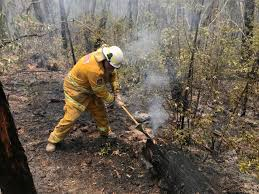Tens of thousands of people were evacuated on Monday as “columns of fire” fueled by extreme heat and high winds bore down on a popular tourist region in Australia’s southeast.
Wildfires that have plagued the country’s eastern coast for weeks flared again to danger levels in Victoria state’s East Gippsland, an area encompassing two national parks, lakes and coastal plains that is half the size of Belgium.
By late afternoon, officials warned holiday makers to stay off the roads because of thick smoke and unpredictable, fast-moving fires, adding that it was now too late for people who had not left the region to do so.
The state’s Emergency Management Commissioner Andrew Crisp said “columns of fire” were punching into the atmosphere and generating their own dangerous weather systems.
“There’s lightning coming out of these columns,” Crisp told reporters. “It is unpredictable, it’s dangerous out there.”
With some firefronts stretching more than 1,000 kilometers (621 miles) and temperatures reaching as high as 43 Celsius (109 Fahrenheit), Crisp said the danger will remain high into the evening.
Bushfires have destroyed more than 4 million hectares (9.9 million acres) across Australia in recent weeks – an area the size of Japan. Eight deaths have been linked to the blazes.
At the Shady Gully Caravan Park in Mallacoota, a coastal town in East Gippsland, a manager who gave only his first name, Chris, told Reuters that “people are evacuating and they have evacuated all day. They are leaving.”
At the Mallacoota Beachcomber Caravan Park, a woman who identified herself only as Debbie said some people had chosen to stay to help fight the fires.
“The weather is very still, almost like a smoke haze and its very very hot. No winds,” she told Reuters by telephone.
Around 100 fires are burning across Australia, the bulk of them in the southeast, across the states of Victoria, New South Wales and South Australia. But blazes are also threatening lives and homes on the other side of the country – fires in Western Australia, thousands of kilometers away from the country’s east, broke containment lines north of the port city of Albany on Sunday.
The heat wave in Australia’s south even pushed up the mercury in Tasmania, the country’s closest point to Antarctica, to 40.8 Celsius (105.4°F). That was the hottest ever December temperature recorded in the state capital city of Hobart, according to the Bureau of Meteorology.
DRY LIGHTNING
Authorities across Australia’s south, including fire-ravaged South Australia, warned on Monday that dry lightning could spark further flare-ups overnight even as the temperature is forecast to cool.
Dry lightning occurs when a storm forms from high temperatures, but the much-needed rain evaporates before reaching the ground.
Large parts of Australia have suffered through several years of drought that has created tinder dry conditions, leaving bushland ready to ignite.
In New South Wales state, temperatures are forecast to spike on New Year’s Eve, when hundreds of thousands of people are expected to gather around the harbor in Sydney to watch the city’s world-famous firework celebrations.
Authorities said they are planning to push ahead with the celebrations, despite some calls for the fireworks to be canceled as they have been in rural locations amid fears they would spark more fires.
“If regional areas have had fireworks banned, then let’s not have two classes of citizens,” tweeted New South Wales Deputy Premier John Barilaro, who represents a rural district affected by drought and fire.
An online petition calling for the Sydney spectacle to be canceled and the money given to farmers and firefighters had attracted more than 270,000 signatures by late Monday.
Local government officials backing the celebration point out it is a major tourism drawcard that fills hotels and restaurants.
Meanwhile, volunteer firefighters, who make up a large part of the country’s firefighting resources, received some good news when the federal government said on Sunday it would compensate them for loss of income given the intensity of this year’s bushfire season.
Bowing to political pressure, Prime Minister Scott Morrison said payments of up to A$6,000 ($4,186) would be available for eligible crews who had spent more than 10 days in the field this season.
Morrison returned home early from holidaying in Hawaii ahead of Christmas following the death of two firefighters and amid criticism his government was doing too little to address climate change and a country-wide drought.
Reuters
 Lebanese Ministry of Information
Lebanese Ministry of Information


